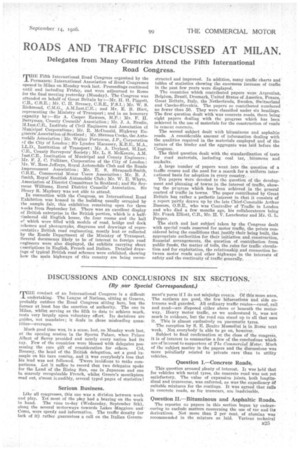ROADS AND TRAFFIC DISCUSSED AT MILAN.
Page 43

If you've noticed an error in this article please click here to report it so we can fix it.
Delegates from Many Countries Attend the Fifth International Road Congress.
THE Fifth international Road Congress organized by the Permanem International Association of Road Congresses opened in Milan on Monday week last. • Proceedings continued until and including Friday, and were adjourned to Rome for the final meeting yesterday(Monday). The Congress waS attended on behalf of Great Britain by :—Mr. H. H. Piggott, C.B.' C.RE. ; Mr. -C. H. Bressey, C.B.E., Mr. W. S. Richmond, C.M.G., • A.M.Inst.C.E.; and Mr. E. B. Hart, representing the Ministry of Transport ; and in an honorary capacity by :—Sir A. Cooper Rawson, M.P.; Mr. F. H. Berryman, County Councils' Association ; Mr. J. A. Brodie, M.Inst.C.E., Institute of Civil Engineers and Association of Munleipal Corporations ; Mr. R. McDonald, Highway Engineers'Association of-Scotland ; Mr. Stenson Cooke, the Automobile Association ; Mr. Walter Fortescue, J.P., Corporation of the City of London ; Sir Lynden MacasseY, K.B.E., M.A., LL.D., Institution. of Transport ; Mr. A. Dryland, M.Inst. C.D. County Surveyors' Society ; Mr, L. S. McKenzie, A.M. Tnst.C.E. Institution of Municipal and County Engineers; Mr. F. J. C. Pollitzer, Corporation of the City of London ; Mr. W. Rees.Jeffreys, Royal Automobile Club and the Roads Improvement Association; Mr. E. S. Shrapnell-Smith, C.B.E., Commercial Motor Users Association; Mr. R. J. fArnith, Royal Scottish Automobile Club; Mr. W. E. Whyte, Association of District Committees in Scotland ; and Sir Seymour Williams, Rural District Councils' Association. Sir Henry R. Maybury was not. able to attend.
In connection with the Congress, an International Road Exhibition was housed in the building usually occupied by the sample fair, this exhibition remaining open for three weeks from September 1st. There was an excellent display of British enterprise in the British portion, which is a halftimbered old English house, the four rooms and the hall oF. which were -filled with models of road, bridge and dock Schemes and photographs, diagrams and drawings of reprosentativa British road engineering, mostly lent or collected by the Roads Department of the Ministry of Transport. Several documents likely to be of interest to foreign road engineers were also displayed, the exhibits carrying short cescriptions in English, French and Italian. Detailed drawings of typical British road schemes were exhibited, showing bow the main highways of this country are being recon
structed and improved. In addition, many traffic charts and tables of statistics showing the enormous increase of traffic in the past few years were displayed.
The countries which contributed papers were Argentina, Belgium, Brazil, Denmark, United States of America, France, Great Britain, Italy, the Netherlands, Sweden, Switzerland and Czecho-Slovakia. The papers so contributed numbered no fewer than 50. They were classified under six headings. The first question dealt with was concrete roads, there being eight papers dealing with the progress which has been achieved in the use of materials for the construction of roads in cement concrete.
The second subject dealt with bituminous and asphaltic roads. , A considerable amount of information dealing with the qualities required in the materials employed and of the nature of the binder and the aggregate was laid before the Congress.
The third question dealt with the standardization of tests for road materials, including coal tar, bitumens and asphalts.
A large number of papers went into the question of a traffic census and the need for a search for a uniform international basis for adoption in every country.
Ten papers were devoted to the question of the development and planning of towns in the interest of traffic, showing the progress which has been achieved in the general control of traffic in towns. The paper contributed by Great Britain has rather a pathetic interest in that it consists of a report partly drawn up by the late Chief-Constable Arthur Bassom, 0.B.E., who was Controller of Traffic in London and who died a few months ago, his collaborateurs being Mr. Frank Elliott, CI., Mn H. V. Lanchester and Mr. G. L. Pepper.
The sixth and last subject taken by the Congress dealt with special roads reserved for motor traffic, the points eonsidered being the conditions that justify their being built, the appropriate authorities for their initiation and construction, financial arrangements, the question of contribution from public funds, the matter of tolls, the rules for traffic circulation and for exploitation, the relationship and connection between motor roads and other highways in the interests of safety and the continuity of traffic generally. .




































































































